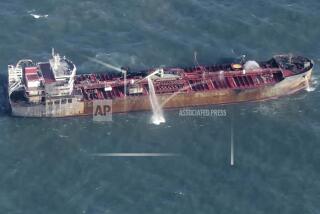How Safe is Safe? And How Expensive? : Five years after the disastrous oil spill from the wreck of the Exxon Valdez, a Pulitzer Prize-winning reporter investigates the tanker industry’s commitment to safety : TANKERS FULL OF TROUBLE, <i> By Eric Nalder (Grove Atlantic Press: $23; 294 pp.)</i>
- Share via
On a storm-wracked voyage from Valdez, Ala., to Cherry Point, Wash., Eric Nalder walked and crawled through every space imaginable on the oil tanker Arco Anchorage. The chief investigative reporter for the Seattle Times, who won a Pulitzer Prize for a series on oil tankers, finally found what he was looking for deep within the bowels of the ship: the crusty chief engineer, an 18-year Arco veteran, “an unblinking witness to the complacency that has eroded public faith in the tanker industry.”
Inside the clanking, hot, seven-tiered engine room, Chief Engineer Jim Vives was responsible for a lot of machinery that was broken or not working very well on the antiquated vessel. “You can’t rely on the corporation,” he muttered. And the corporation, in this case the Atlantic-Richfield Company, had a fairly good reputation.
Nor can we count on the Coast Guard, the federal agency with regulatory powers over oil tanker safety. Nalder quotes an internal Coast Guard report that states the military agency with a civilian job has a tendency to “facilitate commerce” at the expense of safety.
Safety costs money, whether expressed in oil company revenues or larger agency budgets for more inspectors. Except when there is a disastrous oil spill, no one in charge wants to spend much money for something that produces no tangible returns.
Five years after the wreck of the Exxon Valdez (the anniversary is this week, March 24), Nalder concludes: “History shows that things return quickly to business as usual in this tanker trade.” Not only are the oil companies and the Coast Guard responsible, or rather irresponsible, but so are the licensing boards at the state level who rarely censure incompetent pilots; the 42 classification societies who set lower standards for larger ships; and the consumers who demand more oil products.
The crude oil that the Arco Anchorage carried on the 2,400-mile journey across one of the stormiest seas in the world furnished western Washington and Oregon with less than a two-day supply of gasoline, diesel fuel, heating oil, coke, jet fuel, propane, butane, and other refined petroleum products.
There were other tankers immediately ahead and behind the Anchorage that were enroute, not only for Puget Sound, but also for San Francisco Bay and Los Angeles and Long Beach harbors. The “tankers must rumble out of Valdez like clockwork or the freeways in Los Angeles come to a screeching halt,” Nalder observes.
This book, which exhaustively documents the dangers involved in transporting a natural resource to a large metropolitan area, should be required reading for any traveler of those freeways. We need to be reminded, at least in one small way, what the hidden costs are in getting from here to there.
Every generation, it seems, needs this jolt. In 1974 Noel Mostert wrote “Supership,” and now comes Eric Nalder with “Tankers Full of Trouble.” Unfortunately, such excellent efforts make little difference. Near the end of the voyage, the Arco Anchorage stops in Port Angeles for refueling and repairs before the last few miles to Cherry Point. Nalder goes ashore and strikes up a conversation with a stockbroker in a bookstore. The local resident, who is as guilty as the rest of us, says, “The problem, of course, is that we use oil.”
Four days earlier, at the start of the voyage around which the hard information is elegantly clustered, Nalder points out that a toss of the dice will determine whether the 120,000-ton ship--small as far as oil tankers go--with a $16 million cargo and a crew of twenty-four under the command of a 35-year-old captain will make it without a spill.
Along the way we meet the characters, among whom are: the youthful yet competent captain, Jack Carroll, who was elevated from chief mate just six months earlier; the second mate, Jean Holmes, who must make her way in what has traditionally been a man’s world; an elder in the Mormon Church who clashes with a foul-mouthed cook; and the pumpman, Daryl Akey, who works deep within the ship in an all-white room (the better to see leaking oil) that has explosion-proof lights.
We are also introduced to the issues, among which are: the design of tankers, the flags of convenience that hide true ownership, the more notorious tanker accidents, automation of vessels, and the “bean counters” back in the home office who want to run such voyages by fax machine. As the tanker nears the end of its trip there is little we don’t know about this valuable lifeline to energy. What remains is chance, and that is encountered on the last night.
The tanker, as wide as ten highways, must thread its way through the one-lane of Rosario Strait in the pristine San Juan Islands. The third engineer smells smoke, He can’t locate it. He is too busy to call the bridge. The captain and harbor pilot, intent on threading the needle of the strait, are unaware of the impending disaster.
The smoke in the hot, throbbing engine rooms stings the eyes. The trouble, finally located, involves hot oil. Nalder writes, “The accident report would describe how Harrison was burned in the flash fire that followed, and how the blaze spread to the rest of the machinery.”
The fire is extinguished. In this case, it was a winning toss of the dice; and there would be no accident report. “Individual tanker accidents are random and unpredictable events,” notes Nalder, about which little can be done, given the volume of traffic.
More to Read
Sign up for Essential California
The most important California stories and recommendations in your inbox every morning.
You may occasionally receive promotional content from the Los Angeles Times.











